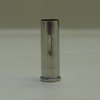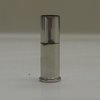beag_nut
Member
Nothing important here, just an interesting case failure and a question.
The pic shows a nickle-plated .357 mag case, which had been reloaded 15-20 times, and which failed inside my SP's cylinder. A relatively mild ".38 spl. +P" load, which went off normally, and was noticed only during extraction, which was sticky. Interesting that the split did not extend to the very rim edge, but there is a tiny split at the rim a short distance away. All in all, just one less case left for reloading. Now the question: this was a W-W Super .357 mag case, plated. I seem to find three times as many plated cases to develop rim splits, compared to plain unplated brass. Any chemists/metallurgists out there who could explain why?

The pic shows a nickle-plated .357 mag case, which had been reloaded 15-20 times, and which failed inside my SP's cylinder. A relatively mild ".38 spl. +P" load, which went off normally, and was noticed only during extraction, which was sticky. Interesting that the split did not extend to the very rim edge, but there is a tiny split at the rim a short distance away. All in all, just one less case left for reloading. Now the question: this was a W-W Super .357 mag case, plated. I seem to find three times as many plated cases to develop rim splits, compared to plain unplated brass. Any chemists/metallurgists out there who could explain why?






 This is what I like about this hobby, it keeps you interested in it.
This is what I like about this hobby, it keeps you interested in it.